|
Animal cells
 Cells in most life forms have adapted to specific roles within an organism.
They can vary in size, shape, composition and function. Bone cells differ
from nerve cells or red blood cells, but they all have features in common
which are characteristic of animal cells.
Cells in most life forms have adapted to specific roles within an organism.
They can vary in size, shape, composition and function. Bone cells differ
from nerve cells or red blood cells, but they all have features in common
which are characteristic of animal cells.
 Viewed through a light microscope, the typical animal cell is composed
of three main structures: a thin cell membrane on the outside, which
encloses the liquid cytoplasm and the cell nucleus.
Viewed through a light microscope, the typical animal cell is composed
of three main structures: a thin cell membrane on the outside, which
encloses the liquid cytoplasm and the cell nucleus.
Cell membrane
The cell membrane is a thin, pliable casing which holds the cell together.
Like a thin plastic bag, it holds the contents of the cell inside. As
it is a semi-permeable membrane (with small holes in its structure),
it allows movement in and out of the cell of molecules like oxygen,
carbon dioxide, water, sugars and other small molecules. Other parts
of the cell membrane actively pump some molecules in and out of the
cell. Without this control, the cell would not survive.
.
Nucleus
The nucleus is the control centre of the cell and is responsible for
the processes that occur in the cell. Without it, the cell does not
have the information required to function and reproduce and cannot survive.
In a typical human cell, the nucleus is 6 micrometres in diameter.
Even so, it contains up to 2 metres of DNA, seen through the microscope
as pairs of chromosomes which determine the individual's characteristics.
At conception, the egg and sperm cells which joined to form the first
cell (zygote) of the new individual carried one set of these chromosomes
from each parent. The zygote therefore has two sets (pairs) of chromosomes,
and every cell made from it by cell division as the organism grows carries
this inherited information.
Cytoplasm
The cytoplasm is the jelly-like substance which makes up the internal
environment of the cell.
In it are found many organelles: specialised, membrane-bound structures
which have specific functions. These carry out chemical reactions, under
the control of the nucleus, for correct functioning
of that particular cell.
Organelles
 There
are six major organelles within the cytoplasm which can only be seen
clearly with an electron microscope. A brief look at their function
helps explain what cells "do" . There
are six major organelles within the cytoplasm which can only be seen
clearly with an electron microscope. A brief look at their function
helps explain what cells "do" .
- Mitochondria are the "power houses"
where cellular respiration occurs. Here chemical energy stored in
sugars is converted to a form useable by the cells. Found in all cells
(animal and plant), they are especially numerous in muscle cells and
nerve cells.
- Ribosomes make proteins which are
used for cell repairs and growth. Other proteins are made such as
enzymes which speed up chemical reactions. These organelles are therefore
numerous in secretion-producing gland cells such as gut lining.
- The Endoplasmic Reticulum is used
to transport molecules, principally proteins made in the ribosomes,
throughout the cell.
- The Golgi Body collects and packages
proteins for transport out of the cell.
- The Centriole is involved in forming
fibres that separate chromosomes when a cell divides.
- In some Protists, a Vacuole is present.
It is a watery, fluid filled sac used to store water, food and some
of the cell's waste materials.
|